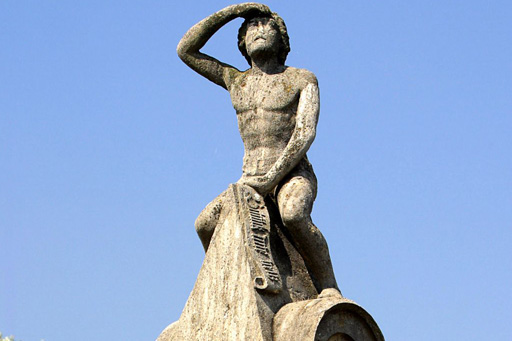

Regensburg in Eastern Bavaria is considered the oldest German city.
If you traveled to Regensburg you approach it by Steinernbrucke or the Romanesque stone bridge of the 12th century. The north end of the bridge was formerly the border between the Duchy (later Electorate) of Bavaria and the Free Imperial City of Regensburg. At the highest point of the bridge is a stone carving called the Bruckmandl or Brückenmännchen (bridge mannikin), a largely naked young man shielding his eyes with one hand and with an inscription reading "Schuck wie heiß" (likely a reference to the hot summer when the bridge was begun. He has been said to symbolise the city's freedoms and its emancipation from the control of the Bishop.
He has also been said to represent the bridge builder, and another figure on the cathedral to represent the cathedral builder. He was originally seated on the roof of a mill, and now sits itself on the roof of a miniature toll-house on the bridge.The current version is the third. The original was replaced in 1579; the current statue was erected on 23 April 1854.The 1579 statue, which lost its legs and arms in the fighting in 1809, is in the Regensburg Historical Museum.There was formerly a crucifix on the bridge which was removed in 1694.
According to a legend the two heads made a bet who will finish the construction first. The master of the bridge construction asked a devil to help him finish the construction of the bridge before. The condition of the devil was that three first souls passing through the bridge would belong to the hell. The bridge master agreed and soon the construction of the bridge was finished. Before the commissioning of the bridge when well known people of the city could participate in the ceremony the master confessed to a local priest about nis deal with the devil. The priest was a wise man and he decided that the devil had not specified if it would be a human or animal soul to belong to the devil and he ordered to put a donkey, a dog and a goose before the people procession.
The bridge also has a number of other sculptures: full statues of Emperor Friedrich II(standing on a masked head with ram's horns, and originally on the now demolished north tower; the current statue is a 1930 replica), Philip of Swabia and his wife Qween Irene (both enthroned and originally on the middle tower; Philip's sculpture is a replica) and reliefs including various arms (including both the city and the bridge itself), heads that may be those of the original builder and the rebuilders later in the Middle Ages, a lizard,a basilisk,a weasel,a lion (replaced with a replica in 1966),two roosters fighting and a reclining dog.
There were also originally an apotropaic mask and a Roman sculpture of a winged lion on the middle tower.The roosters and the dog have been related to the legend about the building of the bridge; alternatively the Bruckmandl, the basilisk, the dog, the three heads and a now lost "small stone within a large stone" which was in the floor of the watchman's hut next to the middle tower have all been interpreted as Christian symbolism indicating that the bridge was the work of a school of clerical architects. www.pragensis.com/tours_in_prague